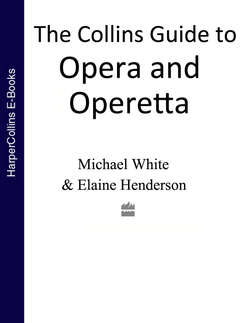Читать книгу The Collins Guide To Opera And Operetta - Michael White - Страница 26
ОглавлениеCandide
FORM: Operetta in two acts; in English
COMPOSER: Leonard Bernstein (1918–90)
LIBRETTO: Lillian Heilman; after Voltaire’s novel
FIRST PERFORMANCE: Boston, 29 October 1956
Principal Characters
Candide, a Westphalian youth Tenor
Cunegonde, his beloved Soprano
Dr Pangloss, Candide’s tutor Baritone
Maximilian, Cunegonde’s brother Baritone
Paquette, Cunegonde’s maid Mezzo-soprano
Old Lady Soprano
Note: Candide was a critical failure when it was first produced in 1956 and there have been several revised versions. The most notable of these was the 1973 version, with a new libretto by Hugh Wheeler. New scenes were introduced, some drawn from Voltaire’s novel, others invented. A 1989 concert version, conducted by Bernstein and performed in London, contains elements from various earlier revisions and is the last form of the work to which the composer gave his approval.
Synopsis of the Plot
The details of the plot vary considerably between the different versions, but in all cases the story concerns the young Candide, who has been taught by Dr Pangloss that ‘everything happens for the best in the best of all possible worlds’. Armed with this unshakeable optimism, Candide sets out on his travels and experiences an endless series of disasters and difficulties, including war, rape, the apparent loss of Cunegonde, betrayal and the disappearance of Dr Pangloss at the hands of the Spanish Inquisition. Candide then leaves Europe in the company of an Old Lady and explores the New World and Eldorado. On his way back the intrepid traveller survives a shipwreck and returns, at last, to his Westphalian home. Here Candide acknowledges his disillusionment with Dr Pangloss’s theories and decides that, even though the world may be full of evil, we must all try to build our own lives on good, honest principles.
Music and Background
The overture to Candide could almost have been Bernstein’s signature tune – brilliant, up-tempo, highly charged – and it opens a piece whose hybrid nature as an up-market, philosophical, operatic operetta always caused problems in casting, staging and selling it to the public. Both words and music underwent extensive revisions over thirty years, with a conveyor belt of collaborating librettists. But the basic idea of high-spirited parody numbers survived in what amounts to an exhilarating mass-rape of European music history, buoyant with catchy, quick-change rhythms. The role of Cunegonde demands a soprano with the coloratura (i.e. embellishing) prowess of a prima donna assoluta; and the score is alive with character parts which are a gift to serious and maybe superannuated opera stars who want to let whatever is left of their hair down.
Highlights
Cunegonde’s exquisitely decorative jewel song ‘Glitter and be gay’ invariably stops the show, although the demands it makes of the singer have no doubt on many an occasion stopped the show ever happening. Candide’s two Act I ‘Meditations’ supply pathos. The big choral finale, ‘Make our garden grow’, is superior Hollywood and deeply moving.
Did You Know?
Lillian Hellman’s original libretto for Candide presented Voltaire’s parable on the evils of paternalistic government as a veiled attack on the McCarthy witchhunt trials.
Recommended Recording
June Andersen, Jerry Hadley, Christa Ludwig, Nicolai Gedda, London Symphony Orchestra/Leonard Bernstein. DG 429 734-2. The legacy of two spectacular concert performances at the Barbican in 1989, with contributions from the Broadway veteran Adolph Green and a lot of chutzpah.
